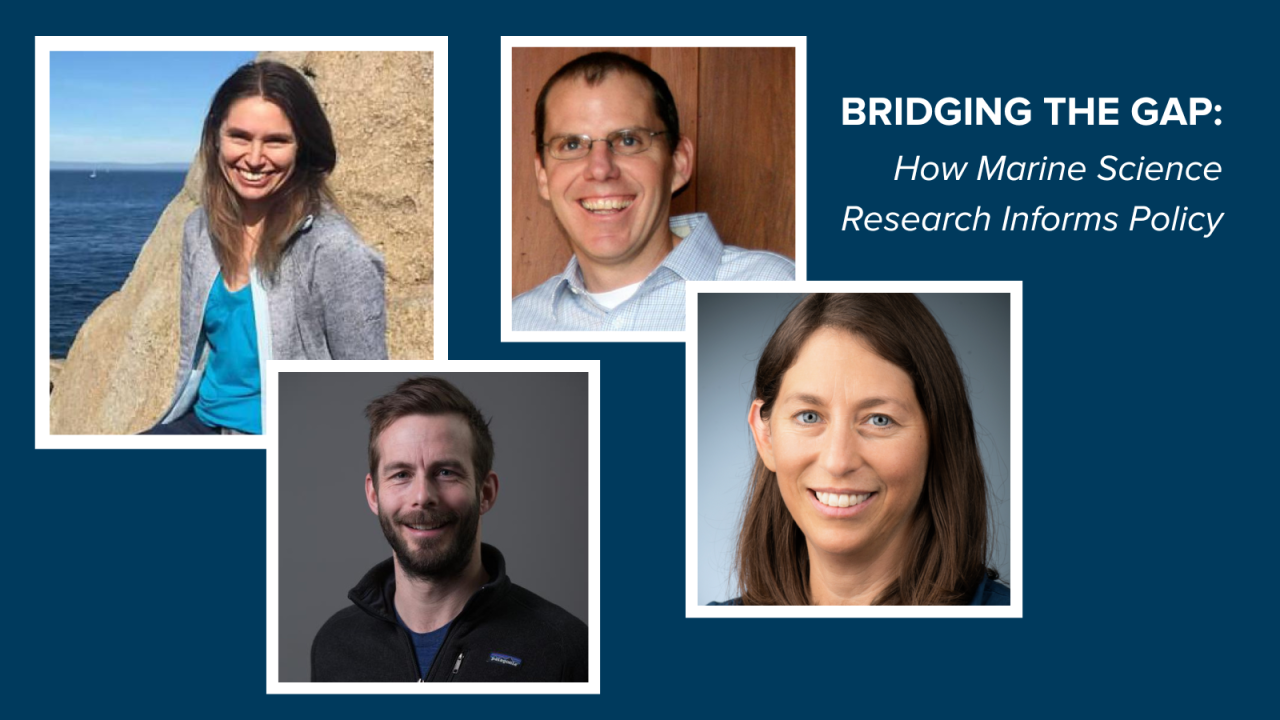
Bridging the Gap Between Research and Policy
Quick Summary
- Scientists at the UC Davis Coastal and Marine Sciences Institute discuss how their research informs and is influenced by policy, illustrating the complex relationship between science, management, and decision-making.
Beyond publishing in academic journals, a crucial aspect of conducting scientific research is communicating findings to the public and translating them into policy action. This connection, while rarely straightforward, is essential for making sure that investments in research inform actions to manage and conserve environmental resources. These four marine scientists illustrate how their work interacts with policy to protect and sustain ocean ecosystems.
Marissa Baskett: Science as a Tool for Policy and Management

Marissa Baskett, a Professor in Environmental Science and Policy and Associate Director of Research Initiatives at the Coastal and Marine Sciences Institute, emphasizes the interplay between science and management in the realm of policy. She explains that while policy outlines broad, legally mandated goals, management provides the specifics on what actions are needed to achieve those goals. Essentially, management is the "how" behind the "what" of policy.
Research helps evaluate the effectiveness of policy by testing and comparing various management strategies, and mathematical models provide a tool to compare expectations from different management approaches to help managers determine which might best achieve a given goal. For example, in her collaborative work on kelp restoration along the California coast, Baskett and her colleagues use models to develop strategies for addressing key drivers of kelp loss, such as ocean warming and sea urchin overpopulation due to a disease outbreak in their predator.
Working alongside other kelp restoration practitioners, her and her students’ research has analyzed potential solutions such as urchin harvesting, where divers remove overpopulated urchins that graze heavily on kelp, and kelp reintroduction through adding spores or small kelp to target locations. Models can also guide restoration efforts by suggesting what types of restoration approaches might best support resilience, or the ability for kelp to recover and persist during marine heat waves. These analyses help identify targeted interventions that consider future environmental changes when restoring ecosystems.
Baskett and other scientists ask, "What tools do we have, how effective are they, and how can they be applied?" Although science doesn’t always directly inform policy, it often leads to new research questions and insights that shape future solutions. "Science may or may not come into [direct] play [with policy]," Baskett notes, "but it’s going to inspire new science to happen."
Karen Shapiro: Policy Shapes Science Communication

For Karen Shapiro, a Professor of Infectious Diseases at UC Davis’ School of Veterinary Medicine, the complex connections between microscopic parasites, wetlands, and beloved sea otters and cats mean that communicating the impacts of one on the others requires nuance and care. Her research focuses on Toxoplasma gondii, a microscopic parasite that threatens sea otters along the Pacific coast, with outdoor cats being a significant source of infection. This is a sensitive topic for both cat owners and wildlife advocates due to the strong emotional connection both groups feel for these animals.
Shapiro explains that how scientific studies are communicated is deeply influenced by policy considerations. Different audiences—whether pet owners, wildlife agencies, or public health officials—require tailored messaging. “I have to be a lot more prepared and even cautious in the messages that I deliver,” Shapiro notes. “I need to know my audience and be respectful of different perspectives.”
The challenge of communicating science is not just about language; it directly impacts how research is applied. While working at the Bodega Marine Laboratory, Shapiro made an important discovery: wetlands could play a crucial role in filtering parasites like Toxoplasma gondii, helping prevent them from reaching the sea. Although her research wasn't initially driven by policy, she recognizes that effectively communicating these findings could inspire discussions with policymakers about the preservation of wetlands.
Models, in particular, have become invaluable tools for understanding ecosystem dynamics and communicating actionable insights. These models can illustrate possible scenarios, for instance, allowing Shapiro's group to test how additional wetland degradation or hypothetical restoration might affect parasite transmission. By focusing on potential outcomes, Shapiro connects her research to real-world decisions, helping guide actions that protect sea otters and important wetland areas. Models like these are also useful beyond academic research. For instance, city planners might use them to predict how new buildings or roads could affect local wildlife, while health experts can model how diseases spread in different environments. In this way, scientific models help people make better decisions in everyday life, from protecting nature to creating safer communities.
Matthew Reimer: Policy as a Driver for Research

Matt Reimer, an Associate Professor in the Department of Agricultural and Resource Economics and the Department of Environmental Science and Policy, finds that policy often drives his research questions rather than the reverse. By actively engaging in policy meetings, Reimer identifies pressing, unanswered questions that require scientific investigation. One of these key issues is understanding how climate change affects fisheries management. To address this, he develops models that explore adaptive strategies, helping communities and industries respond more effectively to shifting environmental and economic conditions.
Rather than concentrating solely on the causes of climate change, Reimer’s research explores practical actions that can be taken to adapt to its effects. His work contributes to shaping policy conversations by providing evidence-based insights into how fisheries management can be improved to remain sustainable in the face of environmental changes.
Jim Sanchirico: Integrating Equity into Environmental Policy

Jim Sanchirico, a Professor of Environmental Science and Policy, emphasizes the growing importance of equity in environmental policy discussions. Recently, he and Reimer participated in a National Academy of Sciences discussion on fisheries and equity. The conversation highlighted a significant gap in data, underscoring that researchers currently lack sufficient information to assess the presence of equity in fisheries management. Reimer explains, “Addressing issues with respect to equity is not going to be a marginal change. You have to rethink entire systems.”
Building on this, Sanchirico draws from his own research in fisheries management in developing regions, such as Indonesia, where households often rely on a combination of activities, including fishing, to sustain their livelihoods. “That research highlighted that fishing is just one piece of the local economy of coastal communities. If you want to think about conservation in the marine environment or reforms to fishery management, you have to understand how it fits into that local economy.” This approach explains why Sanchirico and Reimer call for a comprehensive view of fisheries management—one that integrates economic realities with equity considerations to create more sustainable and inclusive environmental policies.
The Power of Collaboration and Communication
Researchers like Baskett, Shapiro, Reimer, and Sanchirico show that science and policy continuously influence one another. Whether drawing from past studies or engaging in policy discussions, they demonstrate that effective environmental management relies on collaboration and open communication.
By creatively sharing their findings and engaging with diverse stakeholders, these researchers help guide public values and inform policies that protect our oceans for future generations.
